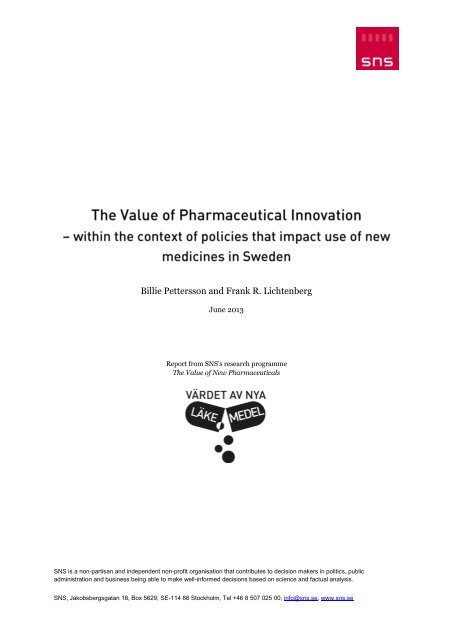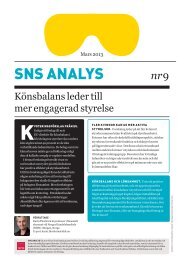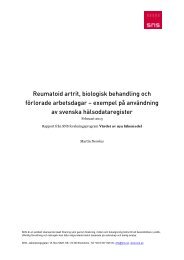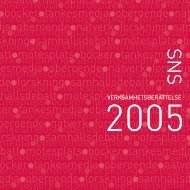Billie Pettersson and Frank R. Lichtenberg - SNS
Billie Pettersson and Frank R. Lichtenberg - SNS
Billie Pettersson and Frank R. Lichtenberg - SNS
You also want an ePaper? Increase the reach of your titles
YUMPU automatically turns print PDFs into web optimized ePapers that Google loves.
undersöks är relaterat till överlevnad, som i och för sig är en vida använd indikator förhälsa, men den ger endast information om kvantiteten, inte kvaliteten av ökad hälsa.Många mediciner ger i huvudsak förbättringar i livskvalitet, vilket alltså inte fångas uppi vår studie. Hur mycket introduktion av nya läkemedel bidrar totalt sett till förbättradhälsa är troligtvis starkt underskattat i denna studie.Läkemedel är en viktig produktionsfaktor i hälso- och sjukvården och därför är det avstor betydelse att dessa – både nya och gamla läkemedel – används på ett optimalt sätt.Som framgår ovan finns en stor potential att nya läkemedel kan förlänga liv och/ellerbidra till att minska användning av <strong>and</strong>ra resurser. Upptag och användning av (nya)läkemedel bestäms av policys och regleringar på olika nivåer: på en makronivå(sjukvårdssystemnivå), organisationsnivå samt på kliniknivå. Det är därför viktigt attutforma policys som kan stödja en optimal användning av samtliga resurser inklusiveläkemedel – nya och gamla. De viktiga frågorna i detta sammanhang är:- Har vi en optimal användning av nya läkemedel?- Avsätter vi tillräckligt mycket resurser för nya läkemedel i förhåll<strong>and</strong>e till nytt<strong>and</strong>e tillför?För att kunna svara på detta behöver man utvärdera tillgänglighet till och upptag av nyaprodukter och de styrsystem som omgärdar detta. Styrsystemen, t.ex. pris- ochsubventionssystemet på nationell nivå och de styrsystem som återfinns på regional nivå,är mycket kraftfulla och har därför avgör<strong>and</strong>e betydelse för användningen av nyaläkemedel. Om dessa styrsystem motverkar effektiv användning av nya läkemedel, somvissa indikatorer tyder på, hämmar det möjligheter för samhället och för patienterna atttillgodogöra sig värdet av de nya läkemedlen.Under de två senaste decennierna har en rad olika reformer på läkemedelsområdetintroducerats, vilka kan ha haft en betyd<strong>and</strong>e effekt på användning av nya läkemedel,men en systematisk och omfatt<strong>and</strong>e utvärdering av dessa system har ännu inte skett.Dock talar en rad indikatorer för att användningen av nya läkemedel i Sverige harsjunkit över åren.En sådan indikator är att utgifterna för läkemedelsförmånen har sjunkit över åren, vilketberor på en mängd faktorer som inte direkt kan hänföras till dessa styrsystem, bl.a. storapatentutgångar, men också på en reell minskning i användning av nya läkemedel. Dettakan vara effekten av ett ökat kostnadsfokus inom l<strong>and</strong>stingen som en effekt av detdecentraliserade kostnadsansvaret som överfördes från staten till l<strong>and</strong>stingen 1998. Enannan faktor som kan ha påverkat tillgängligheten till nya läkemedel är det nya pris- ochsubventionssystemet (P&S) som infördes 2002. Av samtliga mediciner, som erhöllmarknadsgodkänn<strong>and</strong>e åren 2006−2008 i Europa och som finns tillgängliga på de olikamarknaderna, var 75 procent tillgängliga inom läkemedelsförmånerna i Sverige 2009.Pris- och subventionssystemet som tillämpas idag, och som tillkom i samb<strong>and</strong> medupprätt<strong>and</strong>et av Läkemedelsförmånsnämnden (sedermera T<strong>and</strong>vårds- och läkemedelsförmånsverket,TLV), förändrade systemet i grunden, med tillämpningen av ettvärdebaserat prissättningssystem med ekonomiska utvärderingar som grund försubventionsbeslut. Detta system och hur det tillämpas kan verka restriktivt under vissaförutsättningar, t.ex. när det gäller att värdera och premiera stegvis innovation. Förutomatt ett restriktivt P&S-system kan verka hämm<strong>and</strong>e för upptag av nya läkemedel ochanvändning av läkemedel generellt kan det på sikt minska incitament för FoU ochdärmed för framtida försörjning av innovativa läkemedel.5
Ovan nämnda reformer och styrsystem som tillkommit över åren skapar tillsammansförutsättningarna för tillgänglighet och upptag av nya läkemedel och är därföravgör<strong>and</strong>e för hur väl samhället kan tillgodogöra sig potentialen i nya läkemedel. Fördetta krävs en väl utformad och sammanhållen politik. Därför föreslår vi att densammanlagda effekten av de olika regleringar som införts på området och som kan haeffekt på användning av nya läkemedel under de senaste decennierna utreds och attregelsystemen ses över i syfte att skapa förståelse och underlag för utformning avstyrsystem som kan skapa förutsättning för en optimal användning av läkemedel.6
Executive SummaryLife expectancy around the world has increased dramatically over the past fifty years,while at the same time health care spending has risen substantially. Historically it hasbeen difficult to quantify the relationship between health care spending <strong>and</strong>improvements in longevity.We conducted a study to assess the contribution of oneindicator of changes in health care, the introduction of new drugs, to increasedlongevity. New drug launches are of particular interest because they account for asubstantial fraction of medical innovations.We used longitudinal, disease-level data to analyze the impact of pharmaceuticalinnovation on longevity <strong>and</strong> medical expenditure in Sweden during the period1997−2010. We found that diseases that benefited from more pharmaceutical innovationhad greater increases in longevity. Pharmaceutical innovation accounted for almost onethird (31.6%) of the 1.88-year increase in mean age at death during the period1997−2010. Our models included year <strong>and</strong> disease fixed effects, so they controlled forthe overall increase in Swedish longevity <strong>and</strong> for stable between-disease differences inmortality, but not for non-pharmaceutical innovation, which might cause overestimationof the effect from introduction of pharmaceuticals. However, analysis based on U.S.data showed that the rate of pharmaceutical innovation is not positively correlated withthe rate of medical procedure innovation <strong>and</strong> may be negatively correlated with the rateof diagnostic imaging innovation. This suggests that failure to control for other medicalinnovation is very unlikely to result in overestimation of the effect of pharmaceuticalinnovation on longevity growth, <strong>and</strong> may even result in underestimation of this effect.We found that longevity depends on the number of drugs (substances) to treat a disease,not the number of chemical subgroups (drug classes) developed to treat the disease.Diseases that experienced more pharmaceutical innovation saw smaller increases inhospital use. New drugs have been cost saving: the reduction in annual hospitalexpenditure induced by pharmaceutical innovation has been greater than the inducedincrease in annual pharmaceutical expenditure. New drugs have reduced lifetimemedical expenditure, despite the fact that they increased life expectancy by 6 monthsduring 2000−2009.One limitation of this study is that while it does provide information about medicines onan aggregate level, it does not indicate medicines in which to invest. Another limitationis that the outcome measure is related to longevity, which is indeed a widely usedindicator of the health of a population, but it reflects the quantity rather than quality oflife. Many medicines mainly improve quality of life <strong>and</strong> this will not be covered in ourstudy. Nevertheless, the conclusion is that new pharmaceuticals, on an aggregate level,are an important production factor in health care.The uptake <strong>and</strong> use of (new) medicines is determined by policies at several levels: at themacro or healthcare system level, the service organization level <strong>and</strong> the clinical practicelevel. During the last two decades a variety of pharmaceutical policies has beenintroduced in Sweden, which might have had an impact on the use of new medicines,but no thorough <strong>and</strong> complete review of these polices has yet been carried out. Thereare potential new pharmaceuticals that increase life expectancy <strong>and</strong>/or lead to reduceduse of other resources. It is important to prioritize so that resources could be allocated tothese products. Pharmaceutical policies should be balanced to allow society as well as7
patients to benefit from the value of improved health from new medicines, now <strong>and</strong> inthe future, while at the same time considering other policy objectives such as costcontrol.We suggest that the impact of pharmaceutical policies on the use <strong>and</strong> rate of uptake ofnew medicines introduced in recent decades in Sweden be reviewed. It could be usefulto consider this study, for instance, when determining how to optimally invest inpharmaceuticals on an aggregate level.8
1. IntroductionLongevity has constantly been increasing in the Organisation for Economic Cooperation<strong>and</strong> Development (OECD) countries, with the life expectancy at birth nowbeing almost 80 years, on average. The increase in longevity after the first half of 1900is largely attributable to progress in medical technology. Over the same period, healthcare spending has risen substantially.The growth rate in health expenditure has risenmore rapidly than the growth in GDP in many countries during the last few decades <strong>and</strong>constitutes, on average, 10% of GDP in OECD countries 1 , which is also the case forSweden.It has historically been difficult to quantify the relationship between health carespending <strong>and</strong> longevity improvements[1]. We assessed the contribution of one indicatorof changes in health care, the introduction of new drugs, to improved longevity.Launches of new medicines are of particular interest because they account for asubstantial fraction of medical innovations. For instance, expenditures for pharmaceuticalsare around 15% of total health expenditure on average in OECD countries. InSweden, total expenditures for pharmaceuticals had been rising during earlier decadesbut have been declining from 14% of total health care expenditures 2 in 2002 to 12.6% in2010.Extensive research has shown that pharmaceutical innovation has contributed greatly toimproved health. This research is mainly carried out in different therapy areas <strong>and</strong> noton an aggregate level, which might be limiting if the question is how to optimally investin pharmaceuticals on an aggregate level, for instance when the level is to be determinedwithin the state budget.An interesting issue from a policy perspective would be to underst<strong>and</strong> the contributionof pharmaceuticals to the production of health care, in order to ascertain optimal levelsof medicine use that would benefit the society, i.e. the return on investment or the valueof innovation of pharmaceuticals.In 2011 the Swedish government launched an inquiry [2] into certain issues that concernpricing, supply <strong>and</strong> market conditions within the pharmaceutical <strong>and</strong> pharmacy area.Important starting points for a future pricing model, according to the inquiry’s directive,is that it must create preconditions for good cost control at the same time that it mustensure the satisfactory availability of effective pharmaceuticals <strong>and</strong> offer good preconditionsfor the research-based pharmaceutical industry.A report of the inquiry was presented in October 2012 [3]. The report states that neweffective treatments that lead to improved health as well as increased productivity of thehealth care system should be made accessible to patients as early as possible in order toprovide the public with as good <strong>and</strong> modern care as possible. The leading principle forthe inquiry is “that the system for uptake as well as follow-up for new <strong>and</strong> for old drugsshould be designed to support optimal use of medicine” (English translation). Based onthe materials available, the inquiry concluded however that it was not possible to1.OECD Health Data 2012: http://stats.oecd.org/Index.aspx?DataSetCode=SHA2 Total expenditure on pharmaceuticals <strong>and</strong> other medical non-durables .9
ascertain whether use of medicines in Sweden is optimal, or whether the adoption ofnew drugs is too extensive or too restrictive. The uptake <strong>and</strong> use of (new) medicines isdetermined by policies at several levels: at the macro or healthcare system level, theservice organization level <strong>and</strong> the clinical practice level. A variety of national as well asregional policies which might have had an impact on use of pharmaceuticals wereintroduced in Sweden during recent decades, but there is no comprehensive evaluationof these policies <strong>and</strong> what impact these might have had on the uptake <strong>and</strong> use of newmedicines in Sweden.We carried out a study that provides information on the value of pharmaceuticalinnovation by estimating the impact of pharmaceutical innovation on longevity <strong>and</strong> thecost-effectiveness of the new medicines. The contribution of pharmaceutical innovation<strong>and</strong> the cost-effectiveness of that innovation on an aggregate level could be importantindicators of whether pharmaceutical policies are efficient with respect to the rate ofuptake <strong>and</strong> use of new medicines, or when conducting cost-benefit analysis of pharmaceuticalpolicies. This information could be helpful when designing pharmaceuticalpolicies that aim at targeting optimal use of new medicines.The purpose of this report is to provide estimates on the value of pharmaceuticalinnovations within the context of policies that might have affected use of new medicinesin Sweden. The report starts by providing a background on determinants of use of newmedicines, a background on pharmaceutical policies that were introduced during the lastdecade in Sweden <strong>and</strong> finally a section where we review indicators <strong>and</strong> literature on theuse of new medicines in Sweden. In Section 3 we present estimates on the value ofpharmaceutical innovations that were introduced in Sweden 1997−2010 followed by adiscussion of the findings. We present our conclusions <strong>and</strong> summary in Section 4.10
2. Background2.1. Determinants influencing the use of new medicinesPharmaceuticals represent around 15% of overall health expenditure in the OECDcountries, <strong>and</strong> increasing expenditures have led to the introduction of different policiesaimed at controlling costs <strong>and</strong> improving the efficiency of drug use [4]. These policieshave important implications for the access, rate of uptake <strong>and</strong> use of new medicines.Danzon et al. observed that only 23−27% of products launched between 1995−2005were available in countries (such as Sweden) with pricing <strong>and</strong> reimbursement (P&R)control, compared to 63.8% in the US, where access to the market is generally notrestricted by P&R decisions [5].Use of new medical technology varies widely between countries but also betweendifferent disease areas within a country [6]. The causes for variation in diffusion of newdrugs could be differentiated into three broad groups, macro- or system-leveldeterminants, service organization determinants <strong>and</strong> clinical practice determinants [7].These categories are interrelated. For example, a readiness among clinicians to adoptinnovations in clinical practice is determined, to some degree, by the ease with whichaccess to innovation is provided at the system level. The relative importance of thesefactors will vary depending on the disease area in question <strong>and</strong> the system context.In explaining the potential causes of international variation found in the studymentioned above [6], a number of common themes emerges: (1) health technologyassessment (HTA) processes <strong>and</strong> outcomes can have a significant impact on levels ofusage; (2) service planning, organization <strong>and</strong> direction-setting play an important role inenabling or restricting usage; <strong>and</strong> (3) clinical culture <strong>and</strong> attitudes towards treatmentremain important determinants of levels of acceptance. These themes often work incombination, so, for example, the impact of HTA can either be mitigated or amplifiedby issues relating to service organization or clinical culture, where the main issues arethe availability of or access to specialists.2.2. Pharmaceutical policies in SwedenDuring the past two decades, increasing pharmaceutical expenditures led to theintroduction of a variety of mainly dem<strong>and</strong>-side policies aimed at restricting theescalation [8−10]. These policies were designed to promote the rational <strong>and</strong> costeffectiveuse of drugs at national as well as regional levels. Two of the most importantpolicies were the devolution of the pharmaceutical budget to the county councils in1998 <strong>and</strong> implementation in 2002 of a new system for pricing <strong>and</strong> reimbursement(P&R) according to value-based pricing (VBP). There are indications that the policiesintroduced might have had a restrictive impact on the use of (new) medicines inSweden.The prior P&R scheme was replaced by the current VBP system, where HTA became afoundation for P&R decision-making. HTA has emerged as an important foundation forguiding decision-making <strong>and</strong> allocating resources in health care by TLV, Sweden’sDental <strong>and</strong> Pharmaceutical Benefits Agency for making P&R decisions. VBP meansthat a drug’s value, i.e. cost-effectiveness, is evaluated <strong>and</strong> a price premium over its oneor more pre-defined comparators may be determined <strong>and</strong> used to set the price of that11
pharmaceutical. Based on this value assessment, manufacturers are rewarded for thelevel of innovation they bring.In principle, the use of VBP can provide benefits, by enabling governments to makedecisions driven by value, encouraging innovation, <strong>and</strong> providing patients <strong>and</strong>physicians with the information needed to make the best treatment choices. The maindifficulty in defining price (or accepting a price level for listing) via VBP is determininghow to define the value of the medicine in clinical practice <strong>and</strong> challenges related tomeasuring that value. Therefore, the utility of VBP in encouraging innovation <strong>and</strong>value-added health care depends on the assessment process, including when <strong>and</strong> how areview is performed, the chosen comparators <strong>and</strong> the resulting decision-makingprocedures, including implementation. The VBP approach <strong>and</strong> current methodologieswork better in cases with perceived “breakthrough” innovations, while it is much morechallenging when it comes to cases with incremental innovation.The introduction of VBP certainly influenced decision-making concerning newmedicines to be listed <strong>and</strong> made available in the benefits scheme. However, this doesnot mean that the new medicines are being used. Access problems may arise, if theagency performing value assessments does not have a m<strong>and</strong>ate to implement itsdecisions/recommendations [11], as is the case in Sweden <strong>and</strong> other health care systemswith decentralized budgets. There isn’t always consistency between national <strong>and</strong>regional authorities regarding guidelines <strong>and</strong> recommendations. Indeed, at this time,recommendations on some new medicines in the regional guidelines differ from theevaluations <strong>and</strong> decisions made by the TLV. The P&R system not only affects currentaccess to new medicines, it also serves as a signaling system to the industry: it may havea major impact on investment decisions in R&D <strong>and</strong> access to new medicines in thefuture, i.e. dynamic efficiency [12, 13]. As currently implemented, the impact of VBPon dynamic efficiency is not clear at this point [11, 14]. All in all, the VBP approach<strong>and</strong> current methodologies are limited in their ability to deliver relevant knowledge onincremental innovation <strong>and</strong> on dynamic efficiency, <strong>and</strong> this is one of its fundamentalflaws.Another reform that might have had an important impact on access to <strong>and</strong> use ofmedicines concerns the drug budget, which was devolved to the counties in 1998 [8].With the drug budget devolution, an intrinsic conflict arises when the national P&Ragency (TLV) makes decisions about pricing <strong>and</strong> reimbursement based on the costeffectivenessof drugs, while the budget responsibility for drugs falls to the healthcareproviders at the regional level [15]. If health care providers perceive new drugs to be tooexpensive <strong>and</strong> therefore restrain from accepting them, the result may be suboptimaldecisions <strong>and</strong> unnecessary societal costs [16]. Other important factors that might havecontributed to the limited adoption of innovative medicines are the reforms that wereintroduced to encourage so-called “rational use” of prescription medicines regionally,which have kept up with the devolved drug budgets <strong>and</strong> were introduced during recentdecades [9, 17, 18]. These reforms include measures managed via regional Drug <strong>and</strong>Therapeutic Committees, such as the production of regional guidelines, academicdetailing, benchmarking, prescribing targets, <strong>and</strong> economic incentives [8].12
2.3. Access, uptake <strong>and</strong> use of (new) medicines in SwedenIn this section we cover the background on indicators for access, uptake <strong>and</strong> use ofmedicines in Sweden. Access to medicines refers to whether new medicines arelaunched/made available on the Swedish market <strong>and</strong> made available in the reimbursementsystem. Uptake refers to the rate of use of new medicines while use ofmedicines refers to an overall use, which could be use of new as well as old medicines.In a study on international variation in drug usage, volume data were used to measureconsumption in various comparable countries <strong>and</strong> in various different treatment areas[6]. The drugs studied were a combination of new drugs <strong>and</strong> older drugs. Althoughsome countries emerged as generally high or low users of (new) drugs, there is nouniform pattern across disease areas <strong>and</strong> categories of drugs. France, Spain, the US <strong>and</strong>Denmark had high levels of usage generally, but not across all disease areas. Low levelsof usage of (new) drugs were also observed for all four countries in some categories.Generally lower than average levels of usage were observed in Norway <strong>and</strong> Sweden.Sweden had the second lowest ranking out of 14 countries. The ranking for Swedendiffered widely between treatment areas, from (3rd to 13th), where the high ranking (3)was in rheumatoid arthritis <strong>and</strong> the lowest usage was in treatment of osteoporosis (13).The comparison based on cancer treatments could be used as an indicator for use of newdrugs. In that respect Sweden was ranked somewhat higher in use of new cancer drugsintroduced 0−5 years earlier <strong>and</strong> older (introduced more than 10 years earlier) butsomewhat lower for drugs introduced 5−10 years earlier.The report stresses that there is not always a consensus about what the optimum level ofdrug usage in different disease areas would be <strong>and</strong> that the appropriate level of usagemay vary because of different factors at work in different countries. For some diseaseareas, high usage may be a sign of weaknesses at other points in the care pathway <strong>and</strong>low usage a sign of effective disease prevention. Equally, for others, low usage mayimply that patients’ needs are not being met effectively <strong>and</strong> high usage may imply thatpatients are receiving the best treatment.Nevertheless, several indicators have shown that uptake of new medicines has been toorestrictive in Sweden during the last decade. The first dispensing of a drug within a yearafter launch in Sweden was found in 89% of the corresponding in Denmark <strong>and</strong> in 94%in Norway respectively [19]. Between 2006 <strong>and</strong> 2008, 65 new drugs were introduced inEurope, of which 65% were available in Sweden, compared to 89% in Denmark <strong>and</strong>60% in Norway [20]. In a comparison based on 47 innovative drugs in 25 EU-countriesa ranking was made with regard to accessibility. It was found that 22 out of these 47drugs are used in Sweden, which implies a ranking for Sweden at 8 of 25 countries. Theconclusion from the study is that use of medicines varies considerably betweencountries in Europe [21], but the variation could not be explained <strong>and</strong> optimal levelswere not possible to determine in the study. In a comparison of the uptake of newdiabetes <strong>and</strong> anti-coagulant drugs across Europe, uptake in Sweden was found to be atlower range, far below the average in Europe, while the uptake of new drugs to treat thewet form of age-related macular degeneration (AMD) was far above average [22]. In acomparison of the uptake of new cancer drugs in Europe, Sweden was found to be on anaverage [23]. And the uptake <strong>and</strong> use of drugs for multiple sclerosis was above average[24] as was the use of biologic treatments of rheumatoid arthritis also [25]. Furthermore,it is difficult to rank use of medicines on a general level, because of the internalvariation due to different treatment traditions, since the ranking will depend heavily onwhat drugs are included in the comparison. It has been suggested that the main factor13
ehind the escalation in drug costs in Sweden between 1990 <strong>and</strong> 2000 has been achange from the use of old to new <strong>and</strong> expensive drug therapies [26]. During the lastdecade however, pharmaceutical expenditure has been flat [27], <strong>and</strong> the percentage ofoverall drug expenditure in Sweden that was allocated to new medicines introducedduring the preceding five years has declined rapidly from 11% in 2005 to 5% in 2011.This mainly reflects the drop in medicines used in outpatient care. For medicines usedprimarily in hospital care, the development was the opposite, the expenditures onmedicines introduced over the preceding 5 years increased from 8% in 2005 to 14% in2011[3].Information on the rate of uptake of new medicines is limited. However, the TLV,Sweden’s P&R agency, conducted an analysis of medicines for outpatient care, whichconcluded that Sweden provides relatively early access to new drugs, even if noevidence was found that the system leads to much earlier introduction than comparablecountries. The government inquiry concluded that Sweden does not provide earlieraccess to innovative drugs than other countries [3].All in all, the rate of (early) uptake <strong>and</strong> use of medicines seems to be more limited inSweden than it is in several other countries. The impact of this comparatively restrictiveuse should be evaluated <strong>and</strong> considered from a policy perspective. The question iswhether the present practice is the outcome of an informed <strong>and</strong> intentional decision or ifthe policies that were introduced created a system that became too restrictive to beoptimal from a societal perspective.14
3. Value of innovationIncreased longevity is an important part of economic growth <strong>and</strong> development, broadlydefined. In the OECD countries, life expectancy has increased by 10 years since 1960[28]. The enormous monetary value of increasing life expectancy has been noted instudies by Murphy <strong>and</strong> Topel [29]. The economic value of increases in longevity overthe twentieth century has been estimated by Nordhaus in a first approximation to beabout as large as the value of measured growth in non-health goods <strong>and</strong> services [30]<strong>and</strong> the increases in medical spending since 1960 in the USA were found to haveprovided reasonable value [1]. Based on Swedish data, estimates of the monetary valueof increasing life expectancy at birth during the period 1900-2000 suggest that the valueis about 5 million SEK per person <strong>and</strong> the value of the total increase in life expectancywas estimated to be about 75% of the increase in GDP during that period, about 1,552billion SEK [31].Medical innovation has had a major impact on both healthcare outcomes <strong>and</strong> the qualityof care but it may also have been a major driver of health care spending over the postwarperiod [32, 33]. Some studies have concluded that medical innovation has been themain reason for the rise in health care costs. However, some of these studies may nothave fully accounted for spillover across episodes of care or medical conditions. Forexample, a recent study of a cohort of US Medicare beneficiaries aged 65 years <strong>and</strong>older with a diagnosis of cataracts found that patients who had cataract surgery hadlower odds of hip fracture within one year after surgery compared with patients who hadnot undergone cataract surgery [34]. It was found that states that adopted new drugs <strong>and</strong>diagnostic imaging procedures more rapidly did not have larger increases in per capitamedical expenditure, controlling for other factors [35]. Also, <strong>Lichtenberg</strong> (2011) foundthat hospital procedure innovation increased survival of Western Australia hospitalpatients but had a negligible effect on their medical expenditure [36].3.1. Contribution of pharmaceutical innovation to longevity –evidence from SwedenIn this section we summarize the evidence based on data from Sweden on thecontribution of pharmaceutical innovation to longevity, <strong>and</strong> to decreasing use ofhospital days. We also investigate the pharmaceutical expenditures associated withpharmaceutical innovation <strong>and</strong>, finally, we use our estimates on effects <strong>and</strong> costs toestimate the cost effectiveness of pharmaceutical innovation. The entire paper isavailable as a working paper [37] <strong>and</strong> is accepted for publication in Economics ofInnovation <strong>and</strong> New Technology. We used longitudinal, disease-level data to analyzethe impact of pharmaceutical innovation on longevity <strong>and</strong> medical expenditure inSweden during the period 1997−2010. The measures of longevity we used are based onthe age distribution of deaths caused by a disease in a given year <strong>and</strong> in the increase inthe fraction of deaths that occurred at an age greater than 75.Pharmaceutical innovation can be measured in several different ways, because activesubstances are divided into different groups according to the organ or system on whichthey act <strong>and</strong> their therapeutic, pharmacological <strong>and</strong> chemical properties. In theAnatomical Therapeutic Chemical (ATC) classification system developed by the WorldHealth Organization Collaborating Centre for Drug Statistics Methodology, drugs areclassified in groups at five different levels. The highest (1 st ) level is the “anatomical15
main group” level; there are 14 anatomical main groups. The 2 nd , 3 rd , 4 th , <strong>and</strong> 5 th levelsare “therapeutic subgroup,” “pharmacological subgroup,” “chemical subgroup,” <strong>and</strong>“chemical substance,” respectively. 3 The measure of pharmaceutical innovation we usedwas based on the number of drug classes (chemical subgroups) <strong>and</strong> number of drugs(chemical substances) previously introduced to treat a condition.We will investigate the effects of both new chemical substances <strong>and</strong> new chemicalsubgroups on longevity.We pooled data from several rich data sources. Longitudinaldisease-level measures of pharmaceutical innovation were constructed fromLäkemedelsverket (Sweden’s Medical Products Agency) 4 <strong>and</strong> from Thériaque. 5Longitudinal disease-level data on mortality was obtained from the WHO MortalityDatabase. 6 Longitudinal disease-level data on hospital utilization was obtained fromEurostat. 7 Longitudinal data on pharmaceutical expenditure <strong>and</strong> innovation, by drugclass, was obtained from the IMS Health MIDAS database. 8 Some additional data wasobtained from the OECD Health database.We used longitudinal, disease-level data to estimate difference-in-differences models ofthe effect of pharmaceutical innovation on longevity. In essence, we investigatedwhether the diseases that experienced more pharmaceutical innovation had largerincreases in longevity. Our models include year <strong>and</strong> disease fixed effects, so they willcontrol for the overall increase in Swedish longevity <strong>and</strong> for stable between-diseasedifferences in mortality. From 1997 to 2010, mean age at death increased by 1.88 years,from 78.40 to 80.28 years. We estimate that, if the number of chemical substancesmarketed up to six years earlier had not increased, mean age at death would have increasedby 1.29 years, from 78.40 to 79.69 years (Figure 1). Hence pharmaceuticalinnovation is estimated to have increased mean age at death in Sweden by 0.60 years(7.15 months) during the period 1997−2010 – almost 1/3 (31.6%) of the overall increasein mean age at death. It accounted for twice as large a fraction (63%) of the increase inthe fraction of deaths that occurred at an age greater than 75. We found that longevitydepends on the number of drugs to treat a disease, not the number of chemical subgroups(drug classes) developed to treat the disease.3 The complete classification of metformin illustrates the structure of the code:A Alimentary tract <strong>and</strong> metabolism (1st level, anatomical main group)A10A10BA10BADrugs used in diabetes (2nd level, therapeutic subgroup)Blood glucose lowering drugs, excl. Insulins (3rd level, pharmacological subgroup)Biguanides (4th level, chemical subgroup)A10BA02 Metformin (5th level, chemical substance)http://www.whocc.no/atc/structure_<strong>and</strong>_principles/4 http://www.lakemedelsverket.se/Sok-efter-lakemedel-och-mediciner-i-Lakemedelsfakta/5 Thériaque (http://www.theriaque.org/) is a database of official, regulatory <strong>and</strong> bibliographic informationon all drugs available in France, intended for health professionals. Funding is provided by the FrenchCentre National Hospitalier d'Information sur le Médicament.6 http://www.who.int/healthinfo/morttables/en/7 http://epp.eurostat.ec.europa.eu/portal/page/portal/statistics/search_database8 IMS describes MIDAS as “a unique data platform for assessing worldwide healthcare markets. Itintegrates IMS national audits into a globally consistent view of the pharmaceutical market, trackingvirtually every product in hundreds of therapeutic classes <strong>and</strong> providing estimated product volumes,trends <strong>and</strong> market share through retail <strong>and</strong> non-retail channels. MIDAS data is updated monthly <strong>and</strong>retains 12 years of history.” IMS Institute for Healthcare Informatics (2011), The Global Use ofMedicines: Outlook Through 2015, May.http://www.imshealth.com/deployedfiles/ims/Global/Content/Insights/IMS%20Institute%20for%20Healthcare%20Informatics/Global_Use_of_Medicines_Report.pdf16
Figure 1. Mean age at death: Actual vs. in absence of pharmaceutical innovation80,580,080,2879,579,6979,078,578,40In absence of…78,01996 1998 2000 2002 2004 2006 2008 2010 2012We examined the effect of pharmaceutical innovation on hospital use during the period2000−2009. The estimates indicate that an increase in the number of drugs marketed fora disease reduces the number of hospital days (number of discharges <strong>and</strong> length of stay),due to the disease eight years later, primarily due to its effect on the number of hospitaldischarges. We estimated that if no new drugs had been put on the market during theperiod 1992−2001, the number of hospital days would have been about 12% higher in2009 (Figure 2).17
Figure 2. Hospital days, 2000−2009: Actual vs. in absence of pharmaceutical innovation11 000 00010 800 00010 814 60710 600 000if no drugs…10 400 00010 200 00010 000 00010 121 8639 800 0009 600 0009 662 9389 400 0009 200 0001999 2000 2001 2002 2003 2004 2005 2006 2007 2008 2009 2010We then assessed the impact of pharmaceutical innovation on pharmaceutical expenditureusing longitudinal data on about 300 classes of drugs. We estimated that the1997−2006 increase in the number of chemical substances increased pharmaceuticalexpenditure in 2009 by 37.2%.We used our estimates to assess the incremental cost-effectiveness of pharmaceuticalinnovation, i.e. the cost per life-year gained from the introduction of new drugs (Table1). First we calculated a “baseline” estimate of the incremental cost-effectiveness ratio(ICER), based on our estimates that, if no new chemical substances had been marketedduring a previous 9-year period, (1) mean age at death in 2009 would have been 0.47years (5.64 months) lower; (2) per capita pharmaceutical expenditure in 2009 wouldhave been $91 lower; <strong>and</strong> (3) per capita hospital expenditure in 2009 would have been$112 higher. Assuming that pharmaceutical innovation had no effect on other medicalexpenditures, lifetime medical expenditure would have been slightly lower in theabsence of prior pharmaceutical innovation, due to the reduction in life expectancy. Thebaseline estimate of the cost per life-year gained from the introduction of new drugs is$233 (= -$109/ -0.47 years), which is a very small fraction of leading economists’estimates of the value of (or consumers’ willingness to pay) for a one-year increase inlife expectancy.18
Table 1. Estimation of incremental cost effectiveness of pharmaceutical innovationEstimatedvalues in 2009in theabsence of 9prior years ofLine VariableActual values,2009 (Y actual )pharmaceutical innovation(Y no_innovation )Difference(Y no_innovation -Y actual )1 Life expectancy (Mean ageat death)80.03 79.56 -0.47Per capita medicalexpenditure in 2009, USDPPP2 Prescription drugexpenditure$336 $245 -$913 Hospital expenditure $935 $1 047 $1124 Other medical expenditure $2 450 $2 450 $05 Total medical expenditure $3 721 $3 742 $216 Lifetime medicalexpenditure (= lifeexpectancy * total medicalexpenditure in 2009)$297 792 $297 682 -$109We then performed sensitivity analyses. If we assume that there is no hospital costreduction from pharmaceutical innovation, the results indicate that costs are well belowthe consensus value of a statistical life-year. If we assume that the hospital cost reductionis half as large as our estimates indicate, <strong>and</strong> that pharmaceutical innovationalso reduced other medical expenditure (e.g. nursing home expenditure) proportionally,pharmaceutical innovation would be cost-saving.19
3.2.DiscussionFindings based on Swedish data confirmed findings from earlier studies on the contributionof pharmaceutical innovation to longevity using aggregate data [38-40]. Forinstance, the contribution of pharmaceutical innovation to recent longevity growth inGermany was investigated using longitudinal, annual, <strong>and</strong> state-level data during theperiod 2001−2007 [40]. The estimates of the effect of the vintage of prescription drugs(<strong>and</strong> other variables) on life expectancy <strong>and</strong> age-adjusted mortality rates of residents ofGermany implied that about one-third of the 1.4-year increase in German life expectancyduring the period 2001−2007 was due to the replacement of older drugs by newerdrugs. Using patient-level data similar results were observed to the studies based onaggregate data. Patient-level data on health care use from a large number of patients inQuebec, Canada, were linked to survival [41]. The hypothesis was that patients usingnewer medicines were likely to live longer than patients using older medicines,controlling for their medical conditions, age, gender, location <strong>and</strong> so forth. The findingssuggested that new treatments introduced during the last three decades reducedmortality by 51% in the entire study population. Similar results were obtained formortality of cancer <strong>and</strong> of cardiovascular diseases. For review of other studies based onpatient level data, see [42, 43].Innovation is often classified as revolutionary, radical or incremental [44]. The term‘revolutionary’ innovations can be used to describe major conceptual advances, such asthe identification of microbes <strong>and</strong> classes of anti-infection agents. A new underst<strong>and</strong>ingof a disease mechanism <strong>and</strong> a new mode of action that interferes with the diseaseprocess at a molecular level can be described by the term ‘radical’ innovation. A “firstin-class”medicine (the first medicine of its type) is normally considered to be a radicalproduct. Closely related compounds with different attributes that may offer significantvalue in treating particular disease variants or patient segments can be referred to as‘incremental’ innovations.Following Freeman’s classification for products with respect to degree of innovation,the term “substances” in our study refers to incremental innovation, while “classes”refers to radical innovation. A notable finding of our study is that longevity seems todepend on the number of substances, not the number of drug classes launched. Thisfinding means that incremental (same class, but different substances) innovation on anaggregate level can be seen to contribute to improved health <strong>and</strong> also could be costsaving.The increased number of drug substances that we used as a proxy for innovation couldalso mean that more patients are treated, <strong>and</strong> therefore that benefits arise from extendedpatient populations, i.e. a volume component.In addition to the volume component, more innovative substances mean more treatmentoptions that could be used for a better fit with different patients, <strong>and</strong> therefore result inbetter outcomes. This finding is important to consider from a policy perspective since itindicates that horizontal or incremental innovation contributes to health improvement<strong>and</strong> should not be discouraged by policy measures.Overall, the estimates provide support for the hypothesis that an increase in the numberof substances that have been marketed <strong>and</strong> that may be used to treat a disease causes arightward shift of the age distribution of deaths from the disease several years later.20
This could be explained by the fact that a new substance generally will not be widelyused until a few years after it is on the market. The lag in effects might be due todisease-specific progression, but it could also indicate that the uptake of new medicinesis slow <strong>and</strong> that the use is limited at initial launch. Therefore, policies slowing down theuptake of new medicines could delay <strong>and</strong> reduce the health benefits of the innovation.We found that diseases that were the target of more pharmaceutical innovation hadsmaller increases in hospital use, a finding that has also been shown in earlier studies.For instance, there is a study investigating how the use of newer cardiovascular drugscould affect cardiovascular hospitalization, where data from twenty OECD countrieswere used [45]. In countries that adopted new cardiovascular medicines more rapidly,there occurred a more rapid decline in cardiovascular hospitalization. The reduction inexpenditure on cardiovascular hospitalization from the use of new drugs was almostfour times as great as the increase in expenditure on cardiovascular medicines.Another study showed that the increase in the use of HIV-Aids medicines led to asignificant reduction in hospitalization among these patients <strong>and</strong> this saved about$5,000 per patient per year [46]. The consequences of differential adoption of newmedicines on mortality <strong>and</strong> hospitalization were also assessed using US state-level data.States in the US that had greater increases in the proportions of new medicines hadsmaller increases in the number of hospitalizations <strong>and</strong> nursing home admissions perperson, <strong>and</strong> the reduction in costs of admission to hospitals <strong>and</strong> nursing homes wasabout four times as great as the increase in medication costs associated with the use ofnewer medicines [47]. Other studies have shown similar results [47−52].When using the estimates of the effects of pharmaceutical innovation on longevity,hospitalization <strong>and</strong> expenditure to assess the cost-effectiveness of innovation on anaggregate level, innovation seems to be cost-saving compared to no innovation. Thisresult may seem to be counter-intuitive <strong>and</strong> in opposition to what is often demonstratedin studies evaluating the cost-effectiveness of a specific treatment. In a cost-effectivenessanalysis of a new treatment the comparison of the effects <strong>and</strong> costs is typicallymade with another available treatment. Only about 20% of all studies in the Tufts-NewEngl<strong>and</strong> Medical Center Cost-effectiveness registry indicated that treatments werefound to be cost-saving [53], i.e. new drugs could be cost-effective but they are seldompresented as saving costs as compared to older treatments.The diverging results could be due to a difference in methods <strong>and</strong> materials to capturehealth effects <strong>and</strong> the perspective of the analysis, i.e. which costs are included in theanalysis. One possible explanation for why our results indicate cost savings, whileothers do not could be that in most cost-effectiveness studies, some health benefits arenot accounted for. Also extrapolation from clinical trials might not capture all healthbenefits for a specific patient or patient population over time. The cost savings found inour study resulted from decreased hospital days: the reduction in annual hospitalexpenditure induced by pharmaceutical innovation was greater than the inducedincrease in annual pharmaceutical expenditure on an aggregate level, which differs fromthe approach in cost-effectiveness studies where the comparisons are mostly carried outon specific treatments <strong>and</strong> for specific patient populations.Studies can be carried out based on aggregate data <strong>and</strong> on patient-level data. Eachapproach has its strengths <strong>and</strong> limitations. For a detailed methodological discussion21
about the strengths <strong>and</strong> limitations in respective approaches see the review report bySteen Carlsson et al. [54]. In our study the analysis was performed using aggregate data.The most serious criticism of the aggregate approach is the issue of ecological fallacy.This fallacy means that individual members of a group are assumed to have the averagecharacteristics of the group at large. However, statistics that accurately describe groupcharacteristics do not necessarily apply to individuals within that group. Therefore, itmay be argued that patient level data might produce more precise estimates of anintervention in contrast to aggregate data. However, Grunfeld <strong>and</strong> Griliches (1960, p.1)[55] showed that “aggregation of economic variables can, <strong>and</strong> in fact frequently does,reduce…specification errors. Hence, aggregation does not only produce an aggregationerror, but may also produce an aggregation gain.” In particular, patient-level data aresurely more subject to selection effects (the sickest patients might get the newest – oroldest – treatments) than aggregate data.However, it is still important to acknowledge that the aggregate approach does notproduce estimates of the effects of specific treatments. From the present study we areonly able to draw conclusions about the impact of pharmaceutical innovation onlongevity on an aggregate level, <strong>and</strong> not the impact of specific classes or substances. Itis possible that some treatments contributed significantly to the results, while othergroups have not contributed at all, or even had a negative impact. Nevertheless, thisstudy <strong>and</strong> other similar studies are useful as complements to studies on disaggregateddata.To conclude: although studies on an aggregate level have their limitations, they canprovide useful evidence about the overall value of innovation. This information couldbe useful for evaluating <strong>and</strong> designing pharmaceutical policies on a system level, sincethese policies are important determinants of the use <strong>and</strong> uptake of new drugs. Studies ofthe impact of medical innovation on longevity <strong>and</strong> other health outcomes can beconducted using experimental, or quasi-experimental or observational design. The mainlimitation to the interpretation of observational studies, such as ours, is often thepossible presence of unobserved confounders. Selection bias is one of the majorproblems of causal inference based on observational data. We used difference-indifferences(DID) models, which is a quasi-experimental technique used in econometricsthat measures the effect of a treatment at a given period in time, while avoidingconfounding factors, even if DID models do not overcome all bias problems [56]. In ourequations we include variables to represent disease fixed effects <strong>and</strong> year fixed effects,respectively, <strong>and</strong> inclusion of these effects is therefore a difference-in-differencesmodel. Since our models include year <strong>and</strong> disease fixed effects, they will control for theoverall increase in Swedish longevity <strong>and</strong> for stable between-disease differences inmortality.Pharmaceutical innovation is not the only type of medical innovation that is likely tocontribute to longevity growth. Other medical innovation, such as innovation indiagnostic imaging, surgical procedures, <strong>and</strong> medical devices, is also likely to affectlongevity growth. Therefore, measures of these other types of medical innovationshould be included in the longevity model. Unfortunately, longitudinal disease-levelmeasures of non-pharmaceutical medical innovation are not available for Sweden <strong>and</strong>the omission of these variables could result in an overestimation of the effect of theintroduction of pharmaceuticals. However, analysis of longitudinal disease-levelmeasures of non-pharmaceutical <strong>and</strong> pharmaceutical medical innovation available forthe U.S. during the period 1997-2007showed that the rate of pharmaceutical innovation22
is not positively correlated with the rate of medical procedure innovation <strong>and</strong> may benegatively correlated with the rate of diagnostic imaging innovation. This suggests thatfailure to control for other medical innovation is very unlikely to result inoverestimation of the effect of pharmaceutical innovation on longevity growth, <strong>and</strong> mayeven result in underestimation of this effect.A correlation between two variables doesnot necessarily imply that one variable causes the other. The model must be wellspecified such that there is a theoretical reason to believe that any such spuriouscorrelation is avoided. We believe the theoretical reasons as well as empirical findingsfrom experimental clinical research (on the impact from different treatments <strong>and</strong> effectson morbidity <strong>and</strong> mortality, <strong>and</strong> resource consumption) can be used as complementaryevidence of the policy relevance of studies such as ours.23
4. Summary <strong>and</strong> conclusionsIn summary, our study as well as other studies clearly indicates that pharmaceuticalinnovation, on an aggregate level, contributes to improved health <strong>and</strong> might decreasethe need for other health care resources. It is therefore important to design pharmaceuticalpolicies that allow society <strong>and</strong> patients to fully benefit from the value of newmedicines. However, new medicines also add to pharmaceutical expenditures, which onaverage constitute about 15% of overall health expenditures in the OECD countries <strong>and</strong>about 10% in Sweden. Limited resources <strong>and</strong> budget constraints are challenges forpolicy makers. Clearly, policies of investment in health <strong>and</strong> access to medicines need tobe balanced <strong>and</strong> coordinated with other policy goals, i.e. economic, industrial <strong>and</strong>intergenerational policies.One important limitation of our study, since we use aggregate data, is that it lacksability to inform as to which products contributed to the increased life expectancy. Itcould be that some products contributed to a large extent, while others did not. It istherefore important to prioritize so that resources could be allocated to these products,where the most potential benefits exist.Several indicators show that the early uptake <strong>and</strong> use of new medicines have declinedduring the last decades in Sweden, which could be due to the pharmaceutical policiesintroduced during the period. An interesting question is therefore whether investment infaster uptake <strong>and</strong> increased use of medicines within the total health care budget couldproduce even more benefits. Neither the recent Swedish government inquiry nor ourstudy answered that question. However, we found that the introduction of new drugsaccounted for about a third of the longevity increase during the period, whileexpenditure for pharmaceuticals has been stable at around 10% of the total health carebudget. At the same time, our findings suggested that hospital days were reduced,indicating a decreasing pressure on other health care resources.Another important consideration is that in our study we only analyzed how newpharmaceuticals contributed to longevity, which is not the only contribution frompharmaceutical innovation. Many treatments affect mainly patients' quality of life, butthis is not captured in this study. Hence, the contribution of pharmaceutical innovationcould be strongly underestimated with this approach.Early availability of new drugs is just one step towards patients' access to new <strong>and</strong> moreeffective pharmaceutical therapies. Of crucial importance is the timing at which thehealth care providers adopt the new therapies. Our study showed that the benefits interms of longevity <strong>and</strong> decreasing number of hospital days depended on the introductionof new medicines several years earlier. This could mean that the benefits could occurearlier, if the rate of uptake was accelerated.Accessibility of new substances within a class <strong>and</strong> not the number of classes was foundto have significant effects on longevity. One conclusion could be that there is a benefitto encouraging incremental innovation as well as breakthrough innovation. The utilityof VBP in encouraging innovation <strong>and</strong> value-added health care depends largely on theassessment process, including when <strong>and</strong> how the review was performed, <strong>and</strong> resultingdecision-making procedures. Overall, it could be argued that the VBP approach <strong>and</strong>current methodologies are limited in their ability to deliver relevant knowledge on24
incremental innovation <strong>and</strong> on dynamic efficiency, <strong>and</strong> that this is one of itsfundamental flaws. It is however important to prioritize so that resources could beallocated to these products, where the potential of new pharmaceuticals that increase lifeexpectancy <strong>and</strong>/or lead to lower use of other resources exist.There is obviously a need for further discussions of how to shape a system in a way thatwould allow the correct balance between rewarding <strong>and</strong> encouraging manufacturers toproduce innovative new treatments, while at the same time ensuring sustainable healthcare budgets. The question is, did the policies that were introduced create a system thatbecame too restrictive to be optimal from a societal perspective? We believe that currentpolicies, such as the VBP together with the regional reforms <strong>and</strong> decentralized budgetsthat impact the rate of uptake <strong>and</strong> use of new medicines should be carefully reviewedbefore shaping a new system. This is critical to ensure a system with the right <strong>and</strong>desired balance.25
References1. Cutler, D.M., A.B. Rosen, <strong>and</strong> S. Vijan, The value of medical spending in the UnitedStates, 1960-2000.N Engl J Med, 2006. 355(9): p. 920−7.2. Vissa frågor om prissättning, tillgänglighet och marknadsförutsättningar inomläkemedels- och apoteksområdet (2011:55) och Tilläggsdirektiv till utredningen omvissa frågor om prissättning, tillgänglighet och marknadsförutsättningar inomläkemedels- och apoteksområdet (S 2011:07). 2011 [cited; Available from:http://regeringen.se/content/1/c6/17/11/31/f7a53f18.pdf.3. Wallström, S. Pris, tillgång och service – fortsatt utveckling av läkemedels- ochapoteksmarknaden. SOU 2012:75. Delbetänk<strong>and</strong>e av Läkemedels- ochapoteksutredningen 2012 [cited; Available from:http://www.sou.gov.se/pdf/2012/SOU_2012_75_Hela.pdf.4. OECD, Pharmaceutical pricing policies in a global market, in OECD Health PolicyStudies, OECD, Editor. 2008, OECD: Paris.5. Danzon, P.M., Furukawa, M. F., Prices <strong>and</strong> availability of pharmaceuticals: evidencefrom nine countries. Health Aff (Millwood), 2003. Suppl Web Exclusives: p. W3-521-36.6. Richards, M., Extent <strong>and</strong> causes of international variations in drug usage. 2010, CBE:London.7. Nolte, E., Newbould J., Conklin A., International variation in the usage of medicines- Areview of the litterature, in R<strong>and</strong> corporation technical report series. 2010, R<strong>and</strong>Corporation Europe: Cambridge.8. Wettermark, B., Godman, B., Andersson, K., Gustafsson, L. L., Haycox, A., Bertele, V.,Recent national <strong>and</strong> regional drug reforms in Sweden: implications for pharmaceuticalcompanies in Europe. Pharmacoeconomics, 2008. 26(7): p. 537−50.9. Godman, B., Wettermark, B., Hoffmann, M., Andersson, K., Haycox, A., Gustafsson, L.L., Multifaceted national <strong>and</strong> regional drug reforms <strong>and</strong> initiatives in ambulatory carein Sweden: global relevance. Expert Rev Pharmacoecon Outcomes Res, 2009. 9(1): p.65−83.10. Anell, A., Swedish healthcare under pressure. Health Econ, 2005. 14(Suppl 1): p.S237−54.11. Kanavos, P., Nicod, E., Espin, J., <strong>and</strong> van den Aardweg, S., Short- <strong>and</strong> Long-Term Effectsof Value-Based Pricing vs. External Price Referencing. EMINET, 2010.12. Finkelstein, A., Static <strong>and</strong> dynamic effects of health policy: Evidence from the vaccineindustry. Quarterly Journal of Economics, 2004. 119(2): p. 527−564.13. Friederiszick, H., Tosini N., Véricourt de F., Wakeman S., An Economic Assessment ofthe Relationship between Price Regulation <strong>and</strong> Incentives to Innovate in thePharmaceutical Industry, in White Paper No. WP-109-03. 2009, ESMT European Schoolof Management <strong>and</strong> Technology.14. Lundin, D., Ramsberg, J., Dynamic Cost-Effectiveness: A More Efficient ReimbursementCriterion. Forum for Health Economics & Policy, 2008. 11 (2).15. Persson, U., Svensson, J., <strong>Pettersson</strong>, B., A new reimbursement system for innovativepharmaceuticals combining value-based <strong>and</strong> free market pricing.Appl Health EconHealth Policy, 2012. 10(4): p. 217−25.16. Ramsberg, J., Ekelund, M., Stuprörstänk<strong>and</strong>e gör samhällets kostnader för ohälsaonödigt höga. Ekonomisk Debatt, 2011. 39 nr 5.17. Wettermark, B., Godman, B., Jacobsson, B., Haaijer-Ruskamp, F. M., Soft regulations inpharmaceutical policy making: an overview of current approaches <strong>and</strong> theirconsequences. Appl Health Econ Health Policy, 2009. 7(3): p. 137−47.26
18. Godman, B., Sakshaug, S., Berg, C., Wettermark, B., Haycox, A., Combination ofprescribing restrictions <strong>and</strong> policies to engineer low prices to reduce reimbursementcosts. Expert Rev Pharmacoecon Outcomes Res, 2011. 11(1): p. 121−9.19. TLV, TLV:s uppdrag angående omregleringen av apoteksmarknaden.http://www.tlv.se/global/tlvdokument/tlv-slutrapport-omreglering-apoteksmarknad-100413.pdf. 2010.20. EFPIA, Patients W.A.I.T. Indicator, 2009 report. www.efpia.eu. 2010.21. De Cock, J. Results of a comparative study on innovation <strong>and</strong> conclusions of thebackground report, in Ministerial Conference “Innovation <strong>and</strong> Solidarity onPharmaceuticals”. 2010. Brussels -23 & 24 September 2010.22. Access to medicines − time for a progressive model. 2013 [cited 2013 0227]; Availablefrom:http://www.efpia.eu/sites/www.efpia.eu/files/071212_bergstrom_dg_lecture_dec_2012.pdf.23. Wilking, N., Jönsson, B. A pan-European comparison regarding patient access to cancerdrugs. 2005 [cited 2013 20130226]; Available from:http://www.efpia.eu/sites/www.efpia.eu/files/9042%20A%20pan-European%20comparison%20regarding_2005-20100527.pdf.24. Kobelt, G., Kasteng, F. Access to innovative treatments in multiple sclerosis in Europe.2009 [cited 2013 0227]; Available from:http://www.comparatorreports.se/Access%20to%20MS%20treatments%20-%20October%202009.pdf.25. Kobelt, G., Kasteng, F. Access to innovative treatments in rheumatoid arthritis inEurope. 2009 [cited 2013 0227]; Available from:http://www.lif.se/default.aspx?id=44400.26. Gerdtham, U.-G., Lundin, D., Why did drug spending increase during the 1990s? Adecomposition based on Swedish data. Pharmacoeconomics, 2004. 22(1): p. 29−42.27. Läkemedel– statistik för år 2010. 2011 [cited 2012; Available from:http://www.socialstyrelsen.se/Lists/Artikelkatalog/Attachments/18278/2011-3-30.pdf.28. Allender, S., Scarborough, P., Peto, V., Rayner, M., Leal, J., Luengo-Fern<strong>and</strong>ez, R., Gray,A., European cardiovascular disease statistics 2008. 2008, Department of public health,University of Oxford: Oxford.29. Murphy, K.M., Topel, R. H., The value of health <strong>and</strong> longevity. Journal of PoliticalEconomy, 2006. 114(5): p. 871−904.30. Nordhaus, W.D., The Health of Nations: The Contribution of Improved Health to LivingSt<strong>and</strong>ards, in Measuring the Gains from Medical Research: An Economic Approach, K.Murphy, Topel, R., Editor. 2003, University of Chicago Press: Chicago.31. Jönsson, B., Arvidsson, G., Levin, L-Å., Rehnberg, C., Hälsa och tillväxt, in Hälsa, vårdoch tillväxt. 2004, <strong>SNS</strong> Förlag: Stockholm.32. Newhouse, J.P., Medical care costs: how much welfare loss? J Econ Perspect, 1992.6(3): p. 3−21.33. Docteur, E., Oxley, H., Health-Care Systems: Lessons from the Reform Experience. OECDHealth working papers, 2003.34. Tseng, V.L., Yu, F., Lum, F., Coleman, A. L., Risk of fractures following cataract surgeryin Medicare beneficiaries. Jama, 2012. 308(5): p. 493−501.35. <strong>Lichtenberg</strong>, F.R., The quality of medical care, behavioral risk factors, <strong>and</strong> longevitygrowth. Int J Health Care Finance Econ, 2011. 11(1): p. 1−34.36. <strong>Lichtenberg</strong>, F.R., “The Impact Of Therapeutic Procedure Innovation On HospitalPatient Longevity: Evidence From Western Australia, 2000−2007,”http://www.nber.org/papers/w17414; Social Science <strong>and</strong> Medicine). 2011.37. <strong>Lichtenberg</strong>, F.R., <strong>Pettersson</strong>, B. "The impact of pharmaceutical innovation on longevity<strong>and</strong> medical expenditure on Sweden, 1997−2010: evidence from longitudinal, disease27
level data ". CESifo Working Paper Series No. 3894. 2012 [cited 2012 1 September];Available from: http://papers.ssrn.com/sol3/papers.cfm?abstract_id=2133128.Accepted for publication in "Economics of Innovation <strong>and</strong> New Technology".38. <strong>Lichtenberg</strong>, F.R., The impact of new drug launches on longevity: evidence fromlongitudinal, disease-level data from 52 countries, 1982−2001. Int J Health CareFinance Econ, 2005. 5(1): p. 47−73.39. <strong>Lichtenberg</strong>, F.R., Duflos, G., Pharmaceutical innovation <strong>and</strong> the longevity ofAustralians: a first look. Adv Health Econ Health Serv Res, 2008. 19: p. 95−117.40. <strong>Lichtenberg</strong>, F.R., Contribution of pharmaceutical innovation to longevity growth inGermany <strong>and</strong> France, 2001-7. Pharmacoeconomics, 2011. 30(3): p. 197−211.41. <strong>Lichtenberg</strong>, F.R., Grootendorst, P., Van Audenrode, M., Latremouille-Viau, D.,Lefebvre, P., The impact of drug vintage on patient survival: a patient-level analysisusing Quebec's provincial health plan data. Value Health, 2009. 12(6): p. 847−56.42. <strong>Lichtenberg</strong>, F.R., "The Effect of Pharmaceutical Innovation on Longevity: Patient-LevelEvidence from the 1996−2002 Medical Expenditure Panel Survey <strong>and</strong> Linked MortalityPublic-Use Files," Forum for Health Economics & Policy. 2012.43. <strong>Lichtenberg</strong>, F.R., “The effect of drug vintage on survival: Micro evidence from PuertoRico's Medicaid program,” in M. Grossman, B. Lindgren, R. Kaestner, <strong>and</strong> Kristian(eds.), Pharmaceutical Markets <strong>and</strong> Insurance Worldwide (Advances in HealthEconomics <strong>and</strong> Health Services Research, Volume 22), Emerald Group PublishingLimited, pp. 273−292. http://www.ncbi.nlm.nih.gov/pubmed/205752372010.44. Freeman, C., The Economics of Industrial Innovation. 1982, London: Frances Pinter.45. <strong>Lichtenberg</strong>, F.R., Have newer cardiovascular drugs reduced hospitalization? Evidencefrom longitudinal country-level data on 20 OECD countries, 1995−2003. Health Econ,2009. 18(5): p. 519−34.46. <strong>Lichtenberg</strong>, F.R., The impact of increased utilization of HIV drugs on longevity <strong>and</strong>medical expenditure: an assessment based on aggregate US time-series data. ExpertRev Pharmacoecon Outcomes Res, 2006. 6(4): p. 425−36.47. <strong>Lichtenberg</strong>, F.R., The effect of using newer drugs on admissions of elderly Americansto hospitals <strong>and</strong> nursing homes: state-level evidence from 1997 to 2003.Pharmacoeconomics, 2006. 24 Suppl 3: p. 5−25.48. <strong>Lichtenberg</strong>, F.R., ed. “Home, or nursing home? The effect of medical innovation onthe dem<strong>and</strong> for long-term care,” The Economics of New Health Technologies:Incentives, Organisation <strong>and</strong> Financing, ed. J. Costa-Font, McGuire, A., Courbage, C.2009, Oxford University Press.49. <strong>Lichtenberg</strong>, F.R., The impact of new drugs on US longevity <strong>and</strong> medical expenditure,1990-2003: Evidence from longitudinal, disease-level data. American Economic Review,2007. 97(2): p. 438-443.50. <strong>Lichtenberg</strong>, F.R., Are the benefits of newer drugs worth their cost? Evidence from the1996 MEPS. Health Affairs, 2001. 20(5): p. 241−251.51. <strong>Lichtenberg</strong>, F.R., “The Effect of Pharmaceutical Utilisation <strong>and</strong> Innovation onHospitalisation <strong>and</strong> Mortality,” in Productivity, Technology, <strong>and</strong> Economic Growth, B.van Ark, Kuipers, S. K., Kuper, G., Editor. 2000, Kluwer Academic Publishers.52. <strong>Lichtenberg</strong>, F.R., Do (more <strong>and</strong> better) drugs keep people out of hospitals? AmericanEconomic Review, 1996. 86(2): p. 384−388.53. Russell, L.B., Preventing chronic disease: an important investment, but don't count oncost savings.Health Aff (Millwood), 2009. 28(1): p. 42−5.54. Steen Carlsson, K., Persson, U., Gerdtham, U.-G., Värdet av nya läkemedel. 2011,Studieförbundet Näringsliv och Samhälle (<strong>SNS</strong>): Stockholm.55. Grunfeld, Y., Griliches, Z., “Is Aggregation Necessarily Bad?" Review of Economics <strong>and</strong>Statistics 1960. 42(1).28
56. Bertr<strong>and</strong>, M., Duflo, E., Mullainathan, S. How much should we trust differences-indifferencesestimates? 2003 [cited 2012 20 December]; Available from:http://economics.mit.edu/files/750.29
Rapporter från <strong>SNS</strong> forskningsprogram Värdet av nya läkemedelVärdet av nya läkemedel – en förstudie av Ulf-G Gerdtham, Ulf Persson och Katarina SteenCarlsson, Institutet för Hälso-och Sjukvårdsekonomi (IHE), Lund. Maj 2011Målinriktad beh<strong>and</strong>ling av bröstcancer av Adam Lundqvist, Nils Wilking, Ulf-G Gerdtham, UlfPersson och Katarina Steen Carlsson, samtliga knutna till IHE. Januari 2013Medicinska framsteg i beh<strong>and</strong>ling av kronisk myeloisk leukemi av Adam Lundqvist, Anne-Charlotte Norlenius Ohm, Paul Dickman, Martin Höglund, Leif Stenke, Ulf-G Gerdtham, UlfPersson, Magnus Björkholm och Katarina Steen Carlsson, samtliga knutna till IHE. Februari 2013Reumatoid artrit, biologisk beh<strong>and</strong>ling och förlorade arbetsdagar – exempel på användning avsvenska hälsodataregister av Martin Neovius, Institutionen för medicin, Karolinska Institutet.Februari 2013Värdet av statiner – användningsmönster och följsamhet vid beh<strong>and</strong>ling av Ingegärd AnvedenBerglind, Helle Kieler, Marie Linder, Anders Sundström, Björn Wettermark, Anna Citarella ochMorten Andersen, Institutionen för medicin, Karolinska Institutet. Februari 2013Beh<strong>and</strong>ling av diabetes i ett hundraårigt perspektiv av Katarina Steen Carlsson, Christian Berne,Pierre Johansen, Gustav Lanne och Ulf-G Gerdtham, samtliga knutna till IHE. Februari 2013The Value of Pharmaceutical Innovation – within the context of policies that impact use of newmedicines in Sweden av <strong>Billie</strong> <strong>Pettersson</strong>, MSD (gästforskare vid <strong>SNS</strong> i detta projekt) och <strong>Frank</strong>R. <strong>Lichtenberg</strong>, Columbia University, New York. Maj 2013Värdering och implementering av nya läkemedel – med exempel från cancerområdet av BengtJönsson, H<strong>and</strong>elshögskolan i Stockholm, och Nils Wilking, Karolinska Institutet. Maj 2013Professionen, pennan och pengarna – regionala skillnader i användning av läkemedel av MatsBrommels, Johan Hansson, Emma Granström och Emma Wåhlin, Medical Management Centrum(MMC), Karolinska Institutet. Maj 2013Nya läkemedel i tidig implementeringsfas – om förekomst av och kostnader för läkemedelsrelateradsjuklighet av Hanna Gyllensten, Nordic school of public health NHV, Göteborg, ochKatarina Steen Carlsson, IHE. September 2013 (prel.)Räkna med register och r<strong>and</strong>omisera mera! av Martin Neovius och Joakim Ramsberg, KarolinskaInstitutet. September 2013 (prel.)Egenansvar och finansiering av läkemedel – när är det rimligt att betala själv? av Per Carlssonoch Gustav Tinghög, Institutionen för medicin och hälsa, Linköpings universitet. September 2013(prel.)Slutrapport. Oktober 2013 (prel.)
















